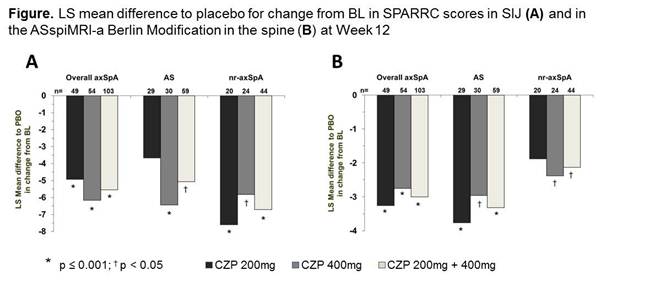Session Information
Title: Spondylarthropathies and Psoriatic Arthritis - Clinical Aspects and Treatment: Spondyloarthritis II
Session Type: Abstract Submissions (ACR)
Background/Purpose:
Axial spondyloarthritis (axSpA) includes both ankylosing spondylitis (AS) and non-radiographic axSpA (nr-axSpA) and is defined by the ASAS criteria.1 It is characterized by bone marrow edema of sacroiliac joints (SIJ) and spine leading to chronic back pain. RAPID-axSpA (NCT01087762) is the first report of the effect of certolizumab pegol (CZP), a PEGylated Fc-free anti-TNF, on inflammation of spine and SIJ in axSpA pts, including both AS and nr-axSpA pt populations, using MRI.
Methods:
The ongoing 158-Wk RAPID-axSpA trial is double-blind and placebo controlled to Wk24, dose-blind to Wk48 and then open label to Wk158. Recruited pts had adult-onset active axSpA defined by the ASAS criteria,1 Bath Ankylosing Spondylitis Disease Activity Index (BASDAI) ≥4, spinal pain ≥4 on a 10 point NRS, and CRP > upper limit of normal or sacroiilitis on MRI. Pts must have failed ≥1 NSAID. Pts could have been secondary failures to 1 previous TNF inhibitor. The pt population reflected the broad axSpA population, including AS pts also meeting the modified New York criteria and nr-axSpA pts who met the ASAS MRI or clinical criteria. Pts were randomized 1:1:1 to placebo (PBO), or 400mg CZP at week (Wk) 0, 2 and 4 (loading dose, LD) followed by either 200mg CZP every 2 weeks (Q2W) or 400mg CZP every 4 weeks (Q4W). MRI scans of the SIJ and spine2, using short-tau-inversion recovery sequences, were performed at baseline (BL) (±3 days) and Wk12 and evaluated using an analysis of covariance model. MRI endpoints were change from BL in the Spondyloathritis Research Consortium of Canada (SPARCC) SIJ score for inflammation and in the Berlin modification of AS spine MRI score for disease activity in the spine (ASspiMRI-a). MRIs were performed in a subset of the pts. Data are reported for all pts who had MRI scans at both BL and Wk12 (the MRI set).
Results:
325 pts were randomized, of which 153 were included in the MRI set. In the MRI set, BL characteristics were similar between treatment groups (PBO/CZP 200mg/CZP 400mg), apart from C-reactive protein (23.9/14.7/15.3 mg/L) and prior anti-TNF exposure (30.0/12.2/9.3%). AS pts had longer symptom duration at BL compared to nr-axSpA pts (mean 12.4 vs. 8.5 yrs ). Within the MRI imaging set, BL SPARCC MRI SIJ scores were comparable between AS and nr-axSpA populations while Berlin ASspiMRI-a scores were higher in AS patients. Improvements in SPARCC MRI SIJ scores and ASspiMRI-a Berlin modification were observed in both CZP dose arms compared to PBO in the overall and in both AS and nr-axSpA populations (Figure). Greater reductions in SIJ inflammation were observed for pt subgroups with <5 yr symptom duration, age <45 yrs and in males.
Conclusion:
CZP reduced inflammation in the SI joints and spine, as assessed by MRI in pts with axSpA, and in both AS and nr-axSpa populations.
References:
- Rudwaleit M. Ann Rheum Dis. 2009;68(6):770-776
- Lambert RGW. Arthritis Rheum 2007;56(12):4005-4040
Disclosure:
D. van der Heijde,
UCB,
5;
W. P. Maksymowych,
UCB,
2,
UCB,
5,
UCB,
8;
R. B. M. Landewé,
UCB,
5;
C. Stach,
UCB,
1,
UCB,
3;
B. Hoepken,
UCB,
3;
A. Fichtner,
UCB,
3;
D. Kielar,
UCB,
1,
UCB,
3;
J. Braun,
UCB,
5,
UCB,
2,
UCB,
8.
« Back to 2012 ACR/ARHP Annual Meeting
ACR Meeting Abstracts - https://acrabstracts.org/abstract/effect-of-certolizumab-pegol-on-inflammation-of-spine-and-sacroiliac-joints-in-patients-with-axial-spondyloarthritis-12-week-magnetic-resonance-imaging-results-of-a-phase-3-double-blind-randomi/

